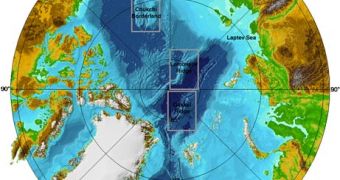Russian hunger for land and oil has not ended and now they back their claim on the North Pole with rock samples taken last month from the floor of the Arctic Ocean at the site of the North Pole, as announced by the Russian government.
Stone analysis has revealed that the Lomonosov Ridge, a submarine structure spreading across the Arctic Ocean beneath the pole, is linked geologically to the Siberian platform. Based on the international law, Russia could exploit the potentially oil-rich seabed covered at the surface by the Arctic ice pack if the ridge is really part of the Russian (Siberian) continental shelf.
"A preliminary analysis confirms the fact that the structure of the Lomonosov Ridge crust matches world analogs of continental crust." has stated Russia's Ministry of Natural Resources.
This would mean that the rock is similar to those encountered on continental shelves, not on the mid-ocean seabeds. The August 2007 Russian mini-sub mission also planted the Russian flag on the Arctic Ocean seabed corresponding to the North Pole, an action without any value under international law.
"It's therefore not surprising the Russians took rock samples at the same time," said Ted McDorman, a professor of law at the University of Victoria in British Columbia.
"Even if the Russians prove that the Lomonosov Ridge's rocks are continental in nature, it doesn't necessarily mean that the ridge is part of Russia. It might be Canadian or Danish. Or it might not be part of any country. Resolving that question will involve studying the entire length of the ridge rather than a single location. The U.S. view is that even if [the ridge] is continental, there's a significant detachment from the mainland," he said.
Even some Russian researchers are cautious.
"The only way to fully verify the claim is to drill into the ridge to take core samples, according to the Norwegian-based news service Barents Observer.com," Boris Morgunov, an advisor to the Russian Ministry of Economic Development, told Echo Moscow radio.
Other Russian officials already see a flourishing Russian oil industry on the North Pole.
"With a high degree of likelihood, Russia will be able to increase its continental shelf by 1.2 million square kilometers [460,000 square miles] with potential hydrocarbon reserves of not less than 9,000 to 10,000 billion tonnes of conventional fuel beyond the 200-mi [322 km] economic zone in the Arctic Ocean," Viktor Posyolov, from Russia's Agency for Management of Mineral Resources, told to news agency Tass.

 14 DAY TRIAL //
14 DAY TRIAL //